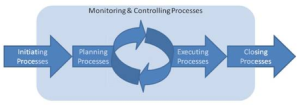In this section, we will explore the basic structure of the PMBOK and how PMI has chosen to organize the 42 different Project Management Processes into five basic categories. Knowledge of how the PMBOK is structured will be key in your efforts to prepare for the certification exam as well as to apply the PMBOK in a practical setting.
Process Groups Definition
Candidates need to know what these process groups are and what they produce. Also interesting to note that within a project, the different phases within the lifecycle of the project will also go through these process groups. For example, during the concept phase of a product, the project team will perform several processes just for that single phase. First you initiate the phase, then you plan it, execute it and finally you close it before moving on to the next phase.
Please refer to Table 3-1 in the PMBOK. You must learn to understand the nature of process interactions. Time spent on this chart is well spent. Memorize this chart. I’ve included a copy of the chart at the bottom of this post, just scroll to the bottom to see it.
It lists all of the 42 Project Management processes listed in the PMBOK that are categorized into 5 Project Management Process Groups. In the exam, you will have to know which of these come from which different process areas. For example, Develop Project Charter is an initiating process.
Knowledge beyond the PMBOK
PMI recognizes that there is more to an effective Project Manager than knowledge of the PMBOK. Figure 3 below highlights some of the different realms of knowledge that PMI believes we should be aware of.
Fig. 5-1 Project Management Realms of Knowledge
For example, under General Management Knowledge and Skills a manager would be responsible for performing activities that would encompass a greater scope than an individual project, such as performing periodic performance evaluations of her staff.
Process Group Interactions
Fig. 5-2 Process Group Interactions
Process groups typically are an iterative process and run serially from Initiating to Planning. You initiate a project and then you begin to plan it and then you execute it. But during your execution, you control it, which may then cause you to re-plan. So there is overlap there until you eventually finish this process group and continue on to the closing processes.
It is important to note that process groups frequently run in parallelto one another, as process groups are not always discrete or separate and there can be some overlap between the various process groups during the course of a project.
In later parts of this course, you will learn that activities relating to Risk Management and Cost management typically run continually throughout the project and do not have a distinct ending point from one process to another.
Table 3-1 Project Management Process Groups and Knowledge Areas Mapping
You will have to become intimately familiar with this table in order to do well in the exam. Think of the table as encompassing the entire ‘universe’ of activities that are necessary to managing a project successfully. All of these processes are interwoven together, as the outputs of one process may become the inputs of others.
It is quite likely that you will see more than one question in the PMP exam testing you on your understanding of a particular process. For example, you may be asked to identify the correct outputs of the Quality Assurance process, or since this is a Multiple Choice Examination, you might be given four options, and three are the correct ones and the other option is incorrect.
In my opinion, these are the preferred examination options, as you will see that it only takes hard work and a bit of memorization to get these types of questions 100% correct. No guess work required. My monkey brain likes that!
Conclusion
In this section, we learnt about Project Management Process Groups and how PMI has chosen to divvy up all 42 Project Management Processes into five general Categories: Initiating, Planning, Executing, Monitoring and Controlling and Closing. We were also introduced to Table 3-1 of the PMBOK, which is an important learning tool for the exam.
In the next section, we will piece together the first 5 sections of the PMP Exam Prep posts and go over an introduction to the Project Management Knowledge Areas, the real meat of the PMBOK.
I hope you guys liked reading this! Feel free to post your comments and feedback. It’s greatly appreciated!
Ook! Road Chimp, signing out.




When someone writes an post he/she maintains the idea of a user in his/her
mind that how a user can know it. Therefore that’s why this piece of writing is outstdanding. Thanks!